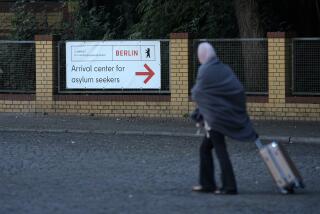A Berlin landmark is on the block
- Share via
BERLIN — Through the failures of the Weimar Republic and the horrors of the Third Reich, in a Germany divided and a Germany reunited, there was always one thing Berliners could count on: their beloved KaDeWe.
More than just a department store, it’s an inescapable fact of life in this European capital. Like Harrods in London or Macy’s in New York, KaDeWe is woven into the fabric of Berlin, a fixture on the urban landscape that’s as much a part of the city’s identity as the Brandenburg Gate or the glass-domed Reichstag, and just as big a tourist draw.
So a lather of righteous indignation was only to be expected when owners of the 102-year-old store announced recently that not only did they want to sell KaDeWe, but they would happily do so to a foreign buyer.
Bring on the offers, the executives said, which prompted some outraged customers to retort: Would you sell your own mother?
“I’ve been shopping here for 30 years,” declared Vera Klimm, 60, emerging from KaDeWe one afternoon with a bagful of evidence to that effect.
“This is an old institution that has survived two world wars. It’s a landmark -- a symbol,” said Klimm, who is adamant that it ought to remain firmly in German hands.
Known formally as Kaufhaus des Westens, KaDeWe is continental Europe’s largest department store, a mecca for well-heeled shoppers in search of goods varying from exotic fruits to the latest Gucci handbag. About 50,000 visitors spin through its revolving doors every day, making it a hive of capitalist activity on the edge of Berlin’s bustling Kurfurstendamm district.
But KaDeWe’s parent company, retailing giant Arcandor, is in debt and in trouble. Hit hard by slumping sales amid the worldwide economic meltdown, the company warned last month that it might have to seek more than $1 billion in new loans to stay afloat.
As part of a restructuring package, Chief Executive Karl-Gerhard Eick said that Arcandor’s three high-end department stores, including KaDeWe and establishments in Hamburg and Munich, might be bundled together and put on the auction block to allow the company to focus on shoring up its Karstadt chain of stores, which appeal to a more middle-class clientele.
The announcement marked the latest chapter in KaDeWe’s tumultuous history, a roller coaster of success, misfortune and rebirth that was launched in 1907 when Adolf Jandorf, a prominent trader, decided to open a department store on trendy Tauentzienstrasse, on Berlin’s upscale west side.
From the start, the building boasted an unrivaled selection of goods on its five sprawling floors. It became a favorite haunt of fashionable members of German society and those who tried their best to emulate them, a place not just to shop but to see and be seen.
The Nazis seized control of the store in 1933 by withholding loans to the Jewish-owned group that then ran KaDeWe. Ten years later, in the thick of World War II, an American warplane crashed into the atrium, reducing what had become an “Aryan”-run establishment to little more than a heap of smoking rubble.
Putting the sundered stones back together was a priority for the postwar government, which saw in KaDeWe’s resurrection a useful metaphor for restoring Berlin’s shattered morale.
If you rebuild it, officials reasoned, they will come again -- and come they did, reviving KaDeWe under the reins of its previous private ownership as a retail powerhouse and turning it into an icon of vibrant free enterprise, especially after the Berlin Wall cleaved the city in two. It was the west’s colorful answer to the east’s whey-faced communism, and West Berliners enjoyed showing off their cathedral of consumerism to wide-eyed visitors from other parts of Germany.
“People know KaDeWe from Bavaria to the Baltic Sea,” store spokeswoman Petra Fladenhofer said.
Although residents like Klimm see KaDeWe as epitomizing the German soul, the store’s local character has already been leached away somewhat in recent years with the arrival of international luxury brands such as Prada, Louis Vuitton and Tommy Hilfiger. In fact, prowling KaDeWe’s aisles, spread out over 650,000 square feet, can now seem indistinguishable from browsing at a Harrods or a Macy’s.
Fladenhofer takes that as a compliment. “Berlin is becoming a more and more international city. People are coming to Berlin expecting these brands,” she said.
The spectacular exception to the homogenization is the store’s food hall, Europe’s largest. KaDeWe’s sixth floor is essentially a colossal deli where Germany’s ingenuity at making every form of sausage imaginable is on proud, and fragrant, display. Chancellor Angela Merkel has been known to shop there, basket in hand, bodyguards hovering amid all that wurst.
In many ways, the indignation in some quarters over a potential sale of KaDeWe to foreign investors is similar to the nationalistic outcry in Britain that greeted the 1985 transfer of ownership of Harrods to the Fayed family of Egypt. But if that sale provides any guide, then the controversy should quickly die down, and shoppers should go back to doing what they do best: shop.
Hamadi Assafe has been a KaDeWe customer for 40 years, stopping in two or three times a month. He will continue to do so, he said, as long as the store continues to meet his needs, regardless of whether the new owners hail from Germany.
“I would have nothing against it,” said Assafe, 62. “The main thing is that the service remains good.”
With that, he exited the store with his latest purchase, a bottle of cologne, as more shoppers eagerly streamed in to take his place.
--
More to Read
Inside the business of entertainment
The Wide Shot brings you news, analysis and insights on everything from streaming wars to production — and what it all means for the future.
You may occasionally receive promotional content from the Los Angeles Times.











